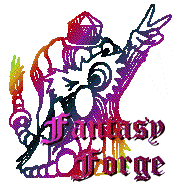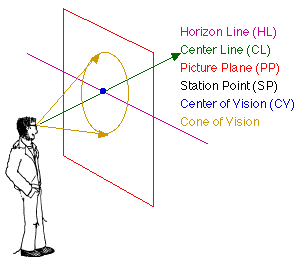
Return to the Perspective Menu
|
Where the World
Ends
What is Art? Ask any group of randomly selected people to
define the word "art" and you may spark a debate. Those who
find a simple explanation with which they are entirely
comfortable have obviously neither given the subject much
thought nor researched the topic. If we assume that artistic
expression is present in drawing, painting, music, dance,
drama, or even web sites, how can we consider one specific
definition to cover all the bases? What part of art do we
consider craft? or talent? or inspiration? Of all the
working definitions commonly in use, most agree on only one
specific point. To be an artist, one must be creative.
|
Creative? This is a loaded word, because like the concept of art,
creativity is another difficult definition. You can neither measure
it, nor quantify it. What does it take to create, and is some
perceived importance of the creation a measure of its worth?
Ultimately, we all must decide these paradoxical conceptualizations
for ourselves.
As artists we have to make decisions on a regular basis. We have
to decide specifics for those who encounter our works. Each decision
builds a foundation for the next one. Eventually so many decisions
have been made that a viable work of art is produced. To not decide
is to flounder, procrastinate, or become nonproductive. To decide is
to produce, and to create. Creativity then might be considered the
end result of a long string of decisions. Once you have made them all
and followed them through, you have accomplished a creative act which
we will here call art.
The subject before us is Linear Perspective, and the
concept we will deal with is our first set of important decisions.
From what point in space is this picture seen? Like a camera
image, painted and drawn pictures are ultimately flat and they appear
to be on a flat surface. Our minds may reconstruct the perceived
foreshortened shapes into mentally recognizable constructs, but
ultimately they are flat shapes on a flat surface. Each image is
drawn or photographed to be seen correctly from one point in space.
Any other angle produces a flattened (even if it is still
understandable) image.
For a camera, this point is simple to reconstruct. It is where the
camera itself was positioned when the picture was taken. Telephoto
lenses can zoom in and enlarge specific parts of the image, but
ultimately this point never actually moves. We refer to this point as
the station point.
When drawing a picture, we have to make some tough decisions right
off. Since there is no camera involved, we have to decide on our own
station point. This decision will influence the rest of the
image, but it is not necessarily a difficult one when we understand
the different angles involved.

Spike has agreed to help us illustrate the most basic angles for a
linear perspective drawing. If you ever see a diagram of a rendering
that has any of the above abbreviations on it, you can be sure that
someone has taken the time to use at least some of these
concepts.
Center Line [of Vision]
(abbreviated CL or
CLV): This imaginary line represents the
center of the viewers field of vision. This line is perpendicular (90
degrees) to the Horizon Line.
Center of Vision (abbreviated
CV): This point represents the place
where the Horizon Line intersects the
Picture Plane.
Horizon Line (abbreviated
HL): This represents the eye level of
the viewer. It is not always necessary to draw this into your
pictures, but it helps to establish one at the beginning in order to
arrange the rest of the composition around it.
Cone of Vision: This is a circular
area about 60 degrees wide (30 degrees above, below, and to each side
of the Center of Vision. Some sources
will place it as far as 90 degrees across, while others will
constrain it closer to 45 degrees. The farther your perspective
drawing travels away from the Center of
Vision, the more warpage that may be detected by
onlookers.
Picture Plane (abbreviated
PP): This is a theoretical flat surface
on which you draw. It is parallel to the
Horizon Line and perpendicular to the
Center Line. You do not need to draw on
this surface while standing at the the Station Point. You can move
closer or farther away, while remembering where everything goes.
Station Point (abbreviated SP): This is the place where the
perspective drawing is best seen from. In a photograph, it would be
the actual place where the camera was when the picture was taken. In
our above diagram it is where Spike's eyes are.
The last basic concept to define is the
Vanishing Point (abbreviated
VP). Vanishing
Points are usually located on the
Horizon Line and represent the place
where objects would diminish in size (remember diminution and
convergence?) to the point that they can no longer be seen
because they are so far away that they appear too small.
There are other concepts to juggle when working in linear
perspective, but these should get us started just fine. Most of the
others can be ignored until we need them later, since they are just
reorganizations and practical applications of the ideas outlined
above. Our next step is to deal with the basic decision making
process for a linear perspective composition.
|Return
to top of page|

